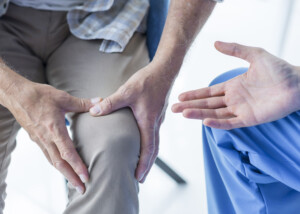A loud, noisy crunching knee, especially with pain, definitely means there’s a problem.
An eventual need for a total knee replacement surgery may be exactly what’s on the sufferer’s mind.
But is a knee replacement surgery likely in that person’s future simply because their knee makes crunching, popping sounds and even feels like something’s grating or grinding inside?
“Not necessarily,” begins Barbara Bergin, MD, board certified orthopedic surgeon at and co-founder of Texas Orthopedics, Sports & Rehabilitation Associates.
“Most arthritic knees are not that ‘noisy.’ The noisiest knees are those which have chondromalacia patella, a condition in which the cartilage under the kneecap is worn out.
“This is a condition suffered more by women because of the way our legs are put together.
“This configuration causes the patella to track abnormally, and the cartilage to wear out prematurely.
“It is rare to do total knee replacement for this condition alone, simply because by avoiding activities such as squatting and stairs, and doing exercises to realign the kneecap, we can diminish the stresses to that cartilage.
“Knee replacements are performed mostly for arthritis of the weight-bearing surfaces of our knees.
“Arthritis of the weight-bearing surface is less likely to cause a lot of loud crunching and grinding.
“Arthritis in these areas can cause a little popping and slight crepitation (crunching), but it’s usually not audible, like the crunching that comes from the kneecap, which is very loud when we take stairs and get up from squats and sitting.
“Occasionally the cartilage under the kneecap is worn so deeply that replacement of that joint alone is required.
“But usually by the time that joint is completely worn out, the rest of the knee has worn out too.”
A study of 3,500 participants, published in 2017 from the Osteoarthritis Initiative, reveals a correlation between noisy knees and an increased risk of developing osteoarthritis, which affects the cartilage NOT under the kneecap but between the bottom of the femur (thigh bone) and the top of the tibia (shin bone).
However, the study did not show cause and effect; only association. Chondromalacia patella does not cause or increase the risk of osteoarthritis.
It may be that the conditions that lead to chondromalacia patella, with its loud crunching noise, may also lead to osteoarthritis.
It’s kind of like obesity leading to heart disease and gout, but heart disease does not cause gout.
Dr. Bergin adds, “I have ‘noisy knees’ because I have chondromalacia patella.
“But I have avoided squats and stair climbing, and have done my exercises, like I told myself to do many years ago, and I have no pain at the age of 65. I’m hopeful I will never have to have knee replacement.”

Dr. Bergin is a general orthopedist, surgically and conservatively treating all manner of bone and joint conditions. She enjoys educating patients so they can emerge stronger than they were before their orthopedic injury or surgery.
 Lorra Garrick has been covering medical, fitness and cybersecurity topics for many years, having written thousands of articles for print magazines and websites, including as a ghostwriter. She’s also a former ACE-certified personal trainer.
Lorra Garrick has been covering medical, fitness and cybersecurity topics for many years, having written thousands of articles for print magazines and websites, including as a ghostwriter. She’s also a former ACE-certified personal trainer.
.









































